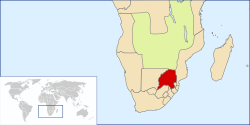Colony of Transvaal
| Transvaal Colony | ||||||||||||
| British colony | ||||||||||||
|
||||||||||||
|
Location of Transvaal, ca. 1890
|
||||||||||||
| Capital | Pretoria | |||||||||||
| Languages |
Dutch (written) / Afrikaans (spoken) English (official) Tswana Zulu Sotho |
|||||||||||
| Religion | Dutch Reformed, Anglican | |||||||||||
| Government | Constitutional monarchy | |||||||||||
| King | ||||||||||||
| • | 1902–1910 | Edward VII | ||||||||||
| • | 1910 | George V | ||||||||||
| Governor | ||||||||||||
| • | 1902–1905 | Viscount Milner | ||||||||||
| • | 1905–1910 | Earl of Selborne | ||||||||||
| Prime Minister | ||||||||||||
| • | 1907–1910 | Louis Botha | ||||||||||
| Historical era | Scramble for Africa | |||||||||||
| • | Established | 12 April 1877 | ||||||||||
| • | Pretoria Convention | 3 August 1881 | ||||||||||
| • | Treaty of Vereeniging | 31 May 1902 | ||||||||||
| • | Union of South Africa | 31 May 1910 | ||||||||||
| Population | ||||||||||||
| • | 1904 est. | 1,268,716 | ||||||||||
|
||||||||||||
| Today part of |
|
|||||||||||
| Warning: Value not specified for "" | ||||||||||||
The Transvaal Colony (Afrikaans pronunciation: [ˈtransfɑːl]) was the name used to refer to the Transvaal region during the period of direct British rule and military occupation between the end of the Anglo-Boer War in 1902 when the South African Republic was dissolved, and the establishment of the Union of South Africa in 1910. The physical borders of the Transvaal Colony were not identical to the defeated South African Republic (which had existed from 1856 to 1902), but was larger. In 1910 the entire territory became the Transvaal Province of the Union of South Africa.
Both the Boer republics, the South African Republic known as ZAR and the Orange Free State were defeated in the Anglo Boer War and surrendered to Britain. A peace treaty was signed, the Treaty of Vereeniging which contained the following terms:
In 1902, with peace following the signing of the Treaty of Vereeniging, the new Transvaal colony was faced with intertwined economic and political issues that need to be resolved. The economic issues faced included the restoration of the mining industry to pre-war levels, then growing it further with the need for extra labour, the restoration of the Boers to their lands and increasing the agricultural output of those farms. The political issue faced depended on what side of politics you stood on. The existing British administrators under Alfred Milner wished to anglicise the population through two main means. One by increasing the English speaking population of the Transvaal and secondly teach the Boer children in English with very little Dutch used, followed by self-rule. The Transvaal Boers political objectives was the restoration of self-rule in the colony and the political environment to be dominated by the Boer.
As the war ended the British were faced with a large proportion of Boer men as prisoners of war and their families in concentration camps. As the British followed a scorched earth policy in the Transvaal, Boer lands, stock and farms had been destroyed.
...
Wikipedia



